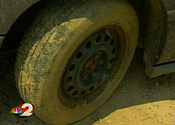Beware of Flood-Damaged Car Stories
Three Stations Fix Up a CARFAX VNR and Sell It As Journalism
 |
| Clients: CARFAX.com |
| Release Date: August 2006 |
| Aired By: 3 stations |
| Disclosed By: 2 stations |
"It's now one year after Hurricane Katrina, and her impact's still being felt," declared WDTN-2 consumer reporter Howard Nathan, in the Dayton, OH, station's August 29 newscast. "Hundreds of thousands of cars were left underwater and declared a total loss. But now Two is on your side to show you exactly how many of these cars can be made to look just like new and may be sold right here."
Unfortunately, the "Buyer Beware" story should have come with a "Viewer Beware" warning, as every fact and frame of Nathan's "report" was taken straight from a video news release (VNR) created by publicists and funded by CARFAX.com, a commercial website that lets customers research a vehicle's history.
The three-minute video—created by the broadcast PR firm Medialink Worldwide—contains plaintive testimony from Diane Zielinski, who had been deceived into buying a flood-damaged car, plus multiple soundbites from CARFAX spokesman Chris Basso. After numerous screenshots of CARFAX.com, the video closes with a heartfelt plug from Zielinski. "Nobody should buy a used car without checking CARFAX.com," she states. "It saves a lot of money. It saves a lot of headaches, so you don't have to go through this kind of problem."
In adapting the VNR, WDTN-2 edited the video for length and enlisted Howard Nathan to re-voice the Medialink publicist's narration. Throughout the entire two-minute segment, Nathan followed the content and structure of the original Medialink script, occasionally matching it word-for-word. Nathan even encouraged viewers to go online and try CARFAX.com. He did at least mention the website's $25 fee, the one piece of information that didn't come from the original VNR.
At the end of the segment, the station displayed a brief label that said "Carfax.com - Katrina Cars." While it's certainly better than no disclosure at all, it would be nearly impossible for viewers to deduce just from the label that the story was furnished by CARFAX.com.
Five days earlier, two other stations had incorporated the VNR into their afternoon newscasts. At KUSA-9 (Denver, CO), anchor Mark Koebrich presented a re-edited and re-voiced version of the VNR that stripped out most mentions of CARFAX.com, and referred viewers instead to a free government website that, like CARFAX, allows users to examine a vehicle's history. At KGTV-10 (San Diego, CA), reporter Marti Emerald adopted her own narrated version of the story, which once again was built entirely from the VNR. Halfway through the story, KGTV-10 flashed an on-screen label that read "Courtesy of Carfax.com," although the disclosure was so brief that it would be easy for viewers to mistakenly assume that CARFAX was only responsible for one brief clip, instead of the entire news story.*
Ultimately, audiences in three states were led to believe they were watching objective journalism, when all they really got was a corporate-funded ad, fixed-up and tricked-out to look like real news.
* The Center for Media and Democracy would like to clarify that, while all of the video in the KGTV-10 segment came from the CARFAX VNR package, reporter Marti Emerald did verbally add information on state and national legislation that came from the station's own reporting. In addition, KGTV-10 managing editor J.W. August has pointed to two on-screen labels—"CARFAX.com - Chris Basso" and "Katrina Cars: Don't Be Fooled - Source: CARFAX.com"—as examples of VNR disclosure. CMD disagrees. The first simply identifies the affiliation of a soundbite speaker, while the second specifically refers to a list of used car buying tips. Neither indicates that the video was funded by, and scripted on behalf of, CARFAX.
| Original CARFAX.com VNR | WDTN-2 5:30 PM newscast |
| Created by Medialink | August 29, 2006 |
| Voiced by publicist | Re-voiced by station reporter |
